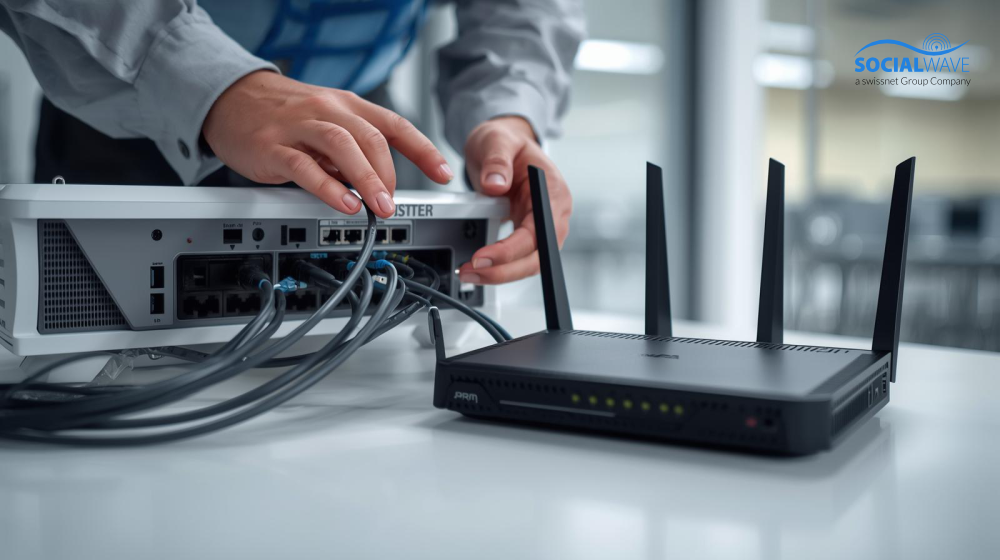7 Easy Tips for Faster WiFi

Who likes slow WiFi? If the YouTube video stutters, the online shop page doesn't load correctly and it takes half an eternity to load the vacation photos into the cloud, it's annoying and takes time unnecessarily. The WLAN signal is often to blame for this. But you can do something about it: We've put together 7 simple and helpful tips for you to make your WiFi faster both at home and in your business.
Basis: do a speed test
First, you should measure the speed of your Internet connection to get a comparison value. This usually only takes a few seconds and can be easily done in the browser, for example here.
You will then be shown an average value for the upload and download speed of your Internet connection. If these values differ significantly from the speed that your tariff or provider promises, there may be various reasons for this. With the following tips, you can easily fix many of these causes yourself and thus make your own WLAN faster and more stable.
1. Set up the router at the optimal location
The WLAN router is often located somewhere in the hallway or in the office in the corner. But just because the telephone connection is located there does not mean that it is a suitable location for a WLAN router.
How decisive the position of the router is for WLAN quality can be illustrated with a simple comparison. WLAN signals behave in a similar way to sound waves that come from a loudspeaker. Music from a loudspeaker is loudest in the immediate vicinity of the loudspeaker. The farther you move away from the loudspeaker, the quieter you hear the music. Similar to a loudspeaker, the waves of a WLAN router also have a limited range. The position of the router is therefore an important criterion for WLAN quality. If you want to listen to music, don't hide the loudspeaker in the shoe rack.
2. Avoid obstacles to the WiFi signal
The WLAN signal is attenuated, for example, by walls, but also by other obstacles such as furniture or metal objects. You should therefore ensure that the router is as “free” as possible. For example, he shouldn't into a cupboard can be placed, but better upon be placed in the cabinet. In general, the higher the router is in the room, the better. In this way, the router can also radiate downwards and the radio waves do not hit obstacles as quickly as tables or chairs. In theory, it would actually be optimal to mount the router on the ceiling.
The WLAN router should not only be as high as possible, but also as centrally located as possible in the apartment, house or business space where the WLAN is used. The closer the router is to the receiving devices, the better the data transfer.
3. Avoid sources of interference with the WLAN signal
Not only walls or furniture, but also electrical appliances such as a wireless telephone, a radio, a television, a microwave or a washing machine can interfere with the WLAN signal with their electromagnetic fields. Therefore, the router should be placed at least 50 centimeters away from such electrical appliances.
If you want to know exactly about the WLAN signal strength, use additional software such as the”Ekahu HeatMapper“to help. This makes it possible to display the signal strength of the WLAN quite precisely for every location in the room.
4. Align antennas correctly
Many WLAN routers have rotatable external antennas. The antennas should each point in different directions so that the WLAN signal is distributed as evenly as possible. Similar to the optimal location for the router, the optimal orientation of the antennas should also be determined by trial and error.
5. Update software on all devices
For the fastest possible connection, it is a basic requirement that all devices are up to date with the latest software version. This applies both to devices and to the WLAN router.
If the software version on your PC, laptop or smartphone is out of date, the WLAN drivers may have errors. You should therefore install available updates and make sure that your device is connected to the network with the latest software.
The router's firmware should also always be up to date. To do this, take a look at the instructions, visit the manufacturer's website, download the latest firmware and install it on the router. If the WLAN signal is weak, it is recommended to set the maximum WLAN signal strength in the router settings, unless the controller is already set to 100% anyway.
If you are a Socialwave customer, rest assured: The firmware of the Socialwave routers is always automatically up to date, as we ensure that new updates are regularly imported via remote maintenance.
6. Increase range with a WLAN repeater or access point
In some cases, the area that the WLAN should cover is simply too large to ensure a sufficiently fast connection in every corner. If the WLAN is used in several rooms, across several floors or in a large hall (commercial), an ordinary router may reach the limit of its range.
A WLAN repeater increases the range relatively easily and conveniently. It is a small, compact device that simply needs to be plugged into a free power outlet. It creates a signal bridge between router and device by picking up the radio signal and transmitting it again in amplified form. The WLAN repeater should be placed as centrally as possible where the WLAN signal is weak. However, the radio waves of the repeater are affected by sources of interference and obstacles, similar to those of the WLAN router, which is why we rather advise our customers against this form of WLAN signal amplification.
A more effective method is to use one or more so-called access points. The access point is connected directly to the WLAN router and serves as a type of extended router. It does not receive the signal via WLAN, but via the LAN cable connected to the router. If the cable is long enough, the access point can simply be placed where the WLAN signal should be reproduced. Although installing an access point is a bit more expensive and complex than installing a repeater, it achieves a longer range with a more stable connection. That is why we always advise our Socialwave customers to amplify their WLAN with access points.
7. Change tariff or Internet provider
Have you tried all of these tips and are still not satisfied with the speed of your WiFi? Then there seems to be only one way out for you: to change your tariff or Internet provider.
If the speed test values largely match the promised figures from your DSL provider, your Internet connection is probably simply too slow for your needs. If you want to stay loyal to your current provider, find out if a faster plan is available at your location. Taking into account your contract period and notice period, switching to another Internet provider is your last option.
If you are a Socialwave customer, you should consider that the speed of the Socialwave router depends on the bandwidth of the upstream DSL router. The guest WLAN can therefore only be as fast as your Internet connection allows. The individual end users share the bandwidth among themselves. If many guests are online at the same time, the WLAN may be relatively slow for individuals. We at Socialwave therefore recommend an Internet connection of at least 16,000 kbit/s for a WLAN speed that is satisfactory for everyone. If no more than 50 people are logged in at the same time, there should be no problems with the standard Socialwave router.
sources:
http://www.pcwelt.de/ratgeber/WLAN-schnell-und-stabil-9762054.html
http://praxistipps.chip.de/wlan-reapeater-oder-access-point-was-ist-der-unterschied_30507








.svg)

.svg)
.svg)



